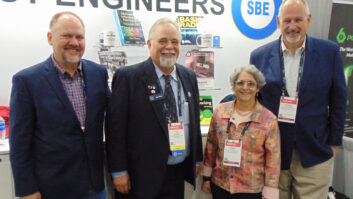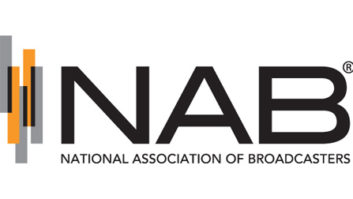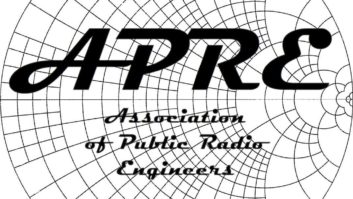Component Killers Question posed in the last issue
(Exam level: CBT)
What are the advantages of a solid-state bridge rectifier over a solid-state full-wave rectifier?
a. Reduced peak inverse voltage rating requirements for the rectifiers
b. Better utilization of the power handling capacity of the supply transformer
c. Reduced voltage drop
d. b & c above
e. a & b above SBE certification is the emblem of professionalism in broadcast engineering. To help you get in the certification exam-taking frame of mind, Radio World Engineering Extra poses a typical question in every issue. Although similar in style and content to the exam questions, these are not from past exams nor will they be on future exams in this exact form.
Our question from last time is shown in the box. The answer is (e).
Discrete components are getting smaller, reaching an extreme in the ultra-miniaturization of surface-mounted technology. Yet simultaneously they are becoming more durable. Present-day silicon diodes are a good example. They are amazing in their durability, frequency response and other qualities compared to similar devices of just a few years ago.
However the greatest stress factor assaulting all components remains the peak applied voltage across them. These potentials, sometimes just transients, are …
The component killers
Diodes are not immune to transients, and the most dynamic conditions are usually found in power supply applications. In the case of rectifier circuits, highly variant voltages can be encountered in the conversion process of AC to DC.
Various rectifying arrangements are available. The question in this column looks at two of the most often encountered configurations, the full-wave center tap (Fig. 1) and the full-wave bridge (Fig. 2), and asks us to differentiate several qualities between them.

Fig. 1: Full-wave CT Configuration

Fig. 2: Bridge ConfigurationVery often we need to transform from line-level AC voltage up or down to an appropriate or optimal voltage level for electronic circuitry requiring DC power. This pedestrian need means that we will quite often have some sort of transformer and rectifier configuration to provide that DC.
In comparing the two arrangements, three specific qualities under review are peak inverse voltage rating requirements for the rectifiers, power handling capacity of the supply transformer and voltage drop through the rectifier path.

Fig. 3: Full-wave CT — D1 Conducts If you were to sample the voltages with your meter, both of the above arrangements have the negative DC polarity present on the ground connection shown at the center tap of the transformer and at ground point of the bridge. Rippling DC would be present before downstream filtering (as shown) on the output side of the diodes.
For clarity, let’s consider the conduction through two configurations in Figs. 3 and 4. If you follow the current flow through the AC cycle in Fig. 3 (a redraw of the full-wave center tap with directional arrows) when the voltage swings positive as marked on the waveform, you will see that a positive current flows through D-1; 180 degrees later, the reciprocal situation would occur and the current would flow through D-2. In both cases the current returns to the transformer through the center tap.

Fig. 4: Full-wave Bridge — Diodes A and C As you can see, in this configuration the inverse voltage potential across each diode is the entire voltage from the transformer secondary.
In Fig. 4, the full-wave bridge, the current flows on the positive swing through diode A. The negative swing on the opposite arm of the transformer pulls current from ground through diode C. In this case the two diodes are in series and the inverse potential across each of them is half of the applied.
Fig. 5 shows the reverse with the positive current flowing through diode B and the negative current through diode D.
Resistor model
When thinking of inverse potentials it’s helpful to view each diode as similar to a resistor (Fig. 6). This drawing would coincide with the current flow shown in Fig. 4. In this analogy, two diodes in series would be double the resistance and hence half of the voltage drop would be impressed across each. The dashed lines represent the extremely low impedance of the conducting diodes, and the resistors the extremely high impedance of the reverse path through the diodes. The full-wave bridge is an improvement over the CT half-wave bridge topology in that the reverse voltage on each diode is reduced. So selection (a) is a valid advantage. We’ll amplify on this virtue in a moment.

Fig. 5: Full-wave Bridge — Diodes B and D Conduct Again looking at the current flow, you’ll notice that in the center-tapped arrangement, power is taken from either side of the transformer center tap alternately. This means that you have to provide essentially two alternate transformers, each working only half the time. That is a lot of extra copper.
In the bridge arrangement the entire secondary winding is used on each polarity of the AC power wave. On a practical level, although this does not translate into exactly half the transformer, a more efficient (smaller and lighter) power transformer can be specified for a bridge vs. a center-tap configuration. So selection (b) is a valid advantage of a bridge over a center-tap configuration.
Incidentally, the above discussion is described and quantified with a wonderful phase that should roll off your tongue like poetry to impress folks with your erudition at cocktail parties, school reunions and the like: transformer utilization factor.
Practice saying this a few times … doesn’t that sound profound?

Fig. 6: Full-wave Bridge — Current Flow AnalogyAll solid-state “junctions,” whether they be in transistors or diodes, have a barrier voltage. This barrier creates a voltage drop across the barrier which varies with construction, fabrication material, count of barriers in parallel, etc. In power diodes such as would be used in these applications, the barrier voltage would typically be around 0.5 volts for each diode. Obviously the simple physics is that the lower the barrier voltage, the lower the power dissipation in the device, and newer junction materials and compounds bring this value down even more in newer premium devices.
The center-tapped rectifier has a single diode in the circuit for each polarity swing and the bridge has two. Not a world-shaking difference numerically (IR drop of 1.0 for the bridge instead of 0.5 volts for the center tap) but measurable just the same and, in some low-voltage circuitry, this drop could be a notable design issue.
So reduced voltage drop is not a quality of a bridge over a center tap and selection (c) is not an advantage.
Answer (e), the advantages of (a) and (b) together, is therefore the correct answer.
Rectifiers and diodes
Let’s strive for some precision and clarify definitions.
A rectifier is a device that converts AC into DC voltage, usually by allowing current to flow mainly in only one direction.
A diode is a device that allows current to flow in only one direction.
We said earlier that we would elaborate about inverse voltage. In early broadcast equipment most rectifiers were gas-filled tubes or selenium (sometimes copper oxide). Both of these had two serious limitations: low inverse voltage capability and low inverse resistance. The ratio of forward and reverse current flow was not all that high, resulting in increased ripple, usually mandating increased filter complexity.
For the former case, you can immediately see why in high-voltage applications a bridge circuit of multiple gas rectifiers would be desirable to lower the inverse voltage demands on each of the tubes or rectifiers.
Even now, what’s inside the typical high-voltage “brick” diode in your FM tube transmitter is a string of diodes connected in series to lower the reverse voltage on each individual diode junction. An interesting (and actually wise) check upon receiving a new “brick” is to measure the barrier voltage drop.
Place a pair of 9 volt batteries in series as a voltage source along with about a 2 k resistor to limit current and then note the voltage drop through the barriers of the “brick” in the forward direction. Divide that voltage drop by 0.5 and you have the approximate number of series diodes inside. If you have any future high-voltage power supply issues, you can recheck the bricks out of the circuit to determine if any of the internal diodes have punched through. Whether you have a standby transmitter and/or your station can tolerate an outage for repair dictates whether you need to replace bricks preemptively with punched-through sections. An imbalance in the count of sections between bricks in a bridge rectifier in a transmitter with minimal filtering will start to show up in increased PS ripple.
We’ll be on the air in 20 minutes …
(click thumbnail)
Fig. 7: The tube and relay components shown occupied an entire cabinet in the transmitter. Because this 50-HG-1 was among the first delivered, a handful of ‘improvements’ were added over time; those were penciled onto the drawing. Schematic courtesy Jeff Hugabone, CE, WTIC(AM). On a historic note, I was surprised to discover that Westinghouse’s innovative 50 kW AM transmitter model 50-HG-1 (first supplied to WTIC here in Hartford in 1947, the year I was born) had “solid-state” bridge rectifiers on supplies up to 3000 volts. Above this voltage level, gas-filled rectifier tubes (model 857B) in bridge configuration were used for the final high-voltage supply.
See tinyurl.com/rwtube, which will open a PDF, if you have an interest in this tube’s parameters.
One of the first high-level, plate-modulated 50 kW transmitters capable of 100 percent modulation, this rig had many leading-edge innovations. However, as an indication of how iffy the gas-filled rectifiers were under the severe high-voltage stress, the transmitter featured a “hot standby.” This model 857 rectifier tube was literally hot, as it took 20 minutes to warm up the rectifiers and distribute the mercury gas evenly in the envelope.
A seventh spare tube was kept “hot” and could actually be relay switched nearly instantly into the circuit by the transmitter engineer as a substitute for whichever of the other six had failed through a nifty set of substitution relay switches. See schematic of the rectifier section, Fig. 7. The dot inside the tube signifies that it is gas-filled as opposed to a vacuum, as would be maintained in a 5U4 rectifier for example.
By contrast, when was the last time you saw a “hot standby” 1N4008?
>> A CBRE-level question for the next Certification Corner. About FET transistors, which of the following is most accurate?

a. The drain is the normal input element akin to a grid in a tube.
b. The gate is the normal input element akin to a grid in a tube.
c. The source is the normal input element akin to a grid in a tube.
d. The screen is the normal input element akin to a grid in a tube.
e. None of the above because an FET is a transistor and so a current amplifier unique to itself.
The deadline to sign up for the next cycle of SBE certification exams is Sept. 18 for testing to be given between Nov. 6 and Nov. 16 in the local SBE chapters.
Buc Fitch, P.E., CPBE, AMD, is a frequent contributor to Radio World. Missed some Certification Corners or want to review them for your next exam? Find past questions at the Certification Column tab under Columns at radioworld.com.











